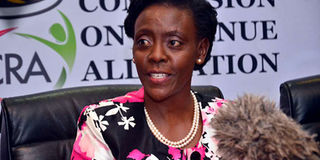Breaking News: CDF Francis Ogolla involved in KDF chopper crash
Why Treasury and CRA funding war persists

Commission for Revenue Allocation Chairperson Jane Kiringai. CRA’s third Revenue Allocation Formula remains stuck at the Senate’s Committee of Finance and Budget. PHOTO | FILE | NATION MEDIA GROUP
What you need to know:
- While the constitution opened up and purposed to demystify the process, the executive has remained hesitant to fully involve others.
- The CRA relies on revenue projections contained in the Budget Review Outlook Paper and the Budget Policy Statement, both documents from the National Treasury.
In the short history of devolution, the stalemate last year over the Division of Revenue Bill proved just who calls the shots when it comes to determining who gets what of the national cake.
For the Senate and the counties that were angling for the Sh335 billion for the devolved units, as had been recommended by the Commission on Revenue Allocation (CRA), the realisation that the holdup was not helping matters eventually broke them down and they were forced to accept the Sh316.5 billion that the National Treasury and the National Assembly, with the backing of President Uhuru Kenyatta, had proposed.
Yet this was not an isolated case. In the first year of devolution, CRA had recommended Sh231 billion for the county governments. The figure eventually came down to Sh190 billion.
The following year, counties got Sh227 billion instead of the Sh279 billion CRA had recommended.
The following year, in 2015/16, counties received Sh260 billion instead of the Sh282 recommended by the commission.
In 2016/17, Sh280 billion was shared among the 47 counties as National Treasury had wanted instead of the Sh332 billion that CRA had recommended.
REALISTIC PICTURE
Then in 2017/18, CRA maintained its figures from the preceding year, but it was still slashed to Sh302 billion.
In 2018/19, CRA’s recommendation of Sh337 billion was slashed to Sh314 billion. Then came 2019 when the stalemate over the Division of Revenue Bill paralysed operations in the counties.
The trend is set to continue this year after it emerged that the National Treasury intends to maintain a figure of Sh316.5 billion for the counties, which is Sh5 billion less CRA’s recommendation.
“Every year, we have been having issues with the Division of Revenue Bill because the CRA and the National Treasury do not coordinate their proposals. Their differences are then brought to the National Assembly, which is supposed to arbitrate. The National Assembly has over the years supported Treasury's position because it presents a more realistic picture, of course with slight adjustments,” said Suba South MP John Mbadi, who sits in the National Assembly’s Budget and Appropriations Committee.
According to CRA commissioner Peter Gachuba, “The commission was and is supposed to be a technical commission with a responsibility in Kenya’s fiscal space, specifically having a constitutional mandate of making recommendations regarding the sharing of revenues between the national government and county governments.”
“Yet in nearly 10 years of its existence, none of the CRA’s recommendations have ever been accepted,” he said.
WHY THE CONFLICT?
So why do the CRA figures get rejected? By virtue of Article 218 (2c), there is no obligation on the National Assembly to accept CRA recommendations on the sharing of revenue between the national and county governments.
But according to CRA chairperson Jane Kiringai, the figures they set ideally should be final and “any divergent views on sharing of revenues should be addressed at the commission before the recommendations are submitted to the relevant institutions” since the National Treasury PS is a CRA commissioner.
“Division on Revenue is still a political and technical issue. A lot of compromises are required in this endeavour. Between December and June when the budget is being prepared, we witness a lot of changes in the fiscal framework,” she said.
While the constitution opened up and purposed to demystify the process, the executive has remained hesitant to fully involve others.
How the National Treasury and the CRA often arrive at different figures is yet another question.
Apparently, the CRA relies on revenue projections contained in the Budget Review Outlook Paper and the Budget Policy Statement (BPS), both documents from the National Treasury.
The documents come out in September and December, respectively, yearly, yet the actual financial figures are only known around February 15 of each year.
CRA'S MISTAKE
That is the time the National Treasury presents the final Budget Policy Statement to Parliament together with the Division of Revenue Bill and County Allocation of Revenue Bill, according to Dr Kiringai.
“CRA recommendations are based on the projections which are provided by the National Treasury,” the CRA chair said.
For instance, in the financial year 2019/20, the projected revenue that CRA used to make its recommendation was Sh1.88 trillion while actual/revised revenue was Sh1.77 trillion.
For the 2020/21 financial year, the projection of Sh1.88 trillion has been revised to Sh1.86 trillion.
Consequently, CRA has often been criticised for “recommending fictitious numbers” or “allocating money that was not available”.
But Mr Mbadi thinks CRA has been “a little bit lazy” in coming up with the recommendations.
“Instead of doing professional work of totally looking at the state of the economy and coming up with recommendations that make a lot of sense and backed with evidence, CRA has been looking at previous year’s figure and wholly relying on the projected growth. Yet a lot of times, the collection of revenue is not in tandem with the growth in GDP,” said Mr Mbadi.
REPORT STALLS
Meanwhile, CRA’s third Revenue Allocation Formula remains stuck at the Senate’s Committee of Finance and Budget more than a year since it was published.
A member of the senate committee, Makueni Senator Mutula Kilonzo Jnr, says the committee carried out public participation the first two weeks of December 2019 but the session expired before they could present their report.
Commissioner Gachuba asserts that CRA did a very good job in the formula work and is confident that it will finally be adopted.
In the absence of a new horizontal revenue sharing formula, Dr Kiringai says the second-generation formula will continue to be used “until such time that Parliament approves the third basis”.



